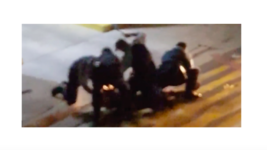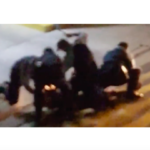Not Guilty Verdict for NSW Police Officer Highlights Bias in Criminal Justice System

Abuse of power and the excessive use of force by police has increasingly come under the scrutiny of mainstream public discourse since the onset of the COVID-19 lockdowns saw law enforcement powers enhanced to administer pandemic restrictions.
Images of Victoria police decked out in military-style riot gear deployed at Melbourne’s Queen Victoria Market in order to suppress an unarmed anti-lockdown protest shocked many, no matter which side of the political divide they sat on when it came to the societywide shutdowns.
Coupled with this has been the uptick in the Black Lives Matter movement since last May. It’s brought the systemic racism that pervades Australian police forces and correctional systems into stark relief.
Although, the renewed focus on a 2018 Bryon Bay incident that involved police being called in to subdue a disoriented and naked 16-year-old – only to go on to use capsicum spray and a taser upon him, as well as hitting him with batons – highlights that police misconduct has long been an issue.
And last week’s finding of not guilty by a Lismore magistrate over an assault charge brought against one of the officers involved in the late night beating of the minor, suggests that the bias in the criminal justice system goes much further than police officers on the beat.
Not guilty verdict
NSW police senior constable Michial Greenhalgh appeared in Lismore Local Court for the last day of hearings over accusations that he’d used “unreasonable force” when hitting the 16-year-old male six times with a baton whilst three officers and two sets of handcuffs were restraining him.
Footage of the 11 January 2018 incident in Lateen Lane in Byron Bay was captured by a nearby witness and later aired on a Current Affair. The 2 minutes and 49 second-long clip clearly shows Greenhalgh striking the teenager on the ground whilst he and two other officers are on him.
Greenhalgh was charged with one count of common assault under section 61 of the Crimes Act 1900 (NSW). The charge related to only six of the 18 baton blows the officer applied, as the initial twelve were carried out prior to the boy’s double handcuffing.
But despite the damning footage that shows the officer, then in his late 30s, striking the teen repeatedly, Magistrate Michael Dakin found Greenhalgh not guilty, stating the officer believed compliance on the part of the youth was not absolute and, therefore, it “necessitated six strikes”.
Conflicting claims
Following the 6 February 2018 airing of the footage on Channel 9, the Law Enforcement Conduct Commission (LECC) received a number of complaints claiming the incident portrayed police abuse of power and excessive use of force. This led the NSW police watchdog to investigate the matter.
Released in September 2018, the Operation Tambora report outlines that around 2 am on the night of the incident, the manager of Nomads Backpacker Hostel called the local police as the naked youth was out the front, acting erratically, calling out for water and making guests uncomfortable.
The youth in question later remarked that he’d taken “acid”, although toxicology tests didn’t identify any specific drug.
The LECC found it was undisputed that the teen was acting strangely. However, while police officers gave evidence that he was aggressive, civilian witnesses cited him as confused and distressed.
The officers claim the youth was not responding coherently to questioning, so they used capsicum spray and then a taser upon him. After that, physical force was used to restrain him, which included repeated baton blows and double handcuffing, due to concerns the initial cuffs were slipping off.
Having committed no real crime, the youth was taken into custody, under the provisions of section 22 of the Mental Health Act 2007 (NSW). This allows officers to take an individual to a mental health facility if they’re showing signs of distress and may pose harm.
The officer in question
The LECC report further sets out that Greenhalgh stands out from the other officers involved in the incident, as the footage clearly shows that when the teen was restrained by three men larger than him, the senior constable continued to apply numerous baton blows.
“Even if one were to accept that there was an appropriate reason for administering baton strikes, the number administered was excessive and not required in the circumstances,” the report reads, adding that the counsel assisting the investigation stated it was “serious misconduct”.
The investigators outlined that Greenhalgh had claimed the use of the baton was necessary, without ever giving reasons as to why it might have been. And while he may have thought he was permitted to act in this manner, the inquiry found objectively it was unreasonable and excessive.
The LECC recommended that the NSW Director for Public Prosecutions (DPP) charge Greenhalgh with assault occasioning actual bodily harm, under section 59 of the Crimes Act. However, he was charged with the lesser offence of common assault on 23 October 2019.
Nothing excessive here
The DPP put it to the senior constable last week that it was unlikely the unarmed, naked teen was going to overpower officers, while the youth was lying motionless and handcuffed with three officers on top of him, which was the point when he laid in six blows.
However, the magistrate raised footage taken of the boy in the custody section of the police station following the incident. It showed several officers holding him down whilst paramedics sedated him, which the judicial officer took to mean the boy was never under complete control.
“The footage in the charge area, where the ambulance officers are in attendance, indicates a number of police were still, at that juncture, required to hold him down to control him,” Magistrate Dakin said. “The footage is self-evident. He’s held down for quite a number of minutes.”
In handing down his not guilty ruling, the magistrate also noted character evidence provided by other senior police, who stated the defendant is an excellent officer that doesn’t resort to violence.
Sergeant John Keough recalled circumstances when Greenhalgh was attending a “rambunctious” homeless person, and he actually gave the man $5 so he could get a coffee to help calm him down.
So, it seems that certain members of the judiciary can’t be swayed by video evidence that shows a police officer beating a restrained minor repeatedly with a baton if other law enforcement officials swear under oath that he’s a stand-up guy.







